 The green sprout at far left. Image: CNSA/Chongqing University
The green sprout at far left. Image: CNSA/Chongqing University
China’s miniature biosphere experiment has yielded sprouting cotton seeds, and they are the first plants to germinate on the Moon—an important first step in creating a viable, self-sustaining lunar colony.
China’s Chang’e 4 lander arrived on the Moon’s far side on January 3, 2018. Among its cargo is a miniature lunar biosphere developed by scientists at Chongqing University. This experiment consists of a 7-inch-long, airtight container filled with soil, air, water, various seeds, yeast, and fruit fly eggs. Together, these components are meant to kickstart a simple ecosystem, the purpose of which is to test the viability of sustaining a future colony on the Moon. A built-in heat system facilitates growth and prevents the biological material from freezing, reports the Xinhua news agency, while two small cameras allow for observations.
An image released today by the China National Space Administration showed green cotton shoots reaching upward from a lattice inside the canister, reports the South China Morning Post. It’s the first time—as far as we know—that a plant has germinated on a Solar System object other than Earth.
That said, it’s not the first time a plant has germinated outside of Earth. In 2015, Expedition 44 astronauts grew—and then consumed—romaine lettuce on the International Space Station.
Seeds brought to the Moon aboard the Chang’e 4 lander include cotton, rapeseed, potato, and arabidopsis (also known as rockcress). Of these, only the cotton seeds have germinated, for reasons that have yet to be determined. The seeds and fruit fly eggs were made dormant using unspecified “biological technology,” during the 20-day journey to the Moon, Xinhua reported. Once on the Moon’s far side, ground control commanded the lander to water the seeds. Xinhua said around 170 photos of the experiment have been captured so far.
“We have given consideration to future survival in space,” Liu Hanlong, who heads the experiment, told SCMP. “Learning about these plants’ growth in a low-gravity environment would allow us to lay the foundation for our future establishment of space base.”
In a hypothetical habitable lunar environment, the cotton seeds could provide material to make fabric, the potatoes and rockcress would provide food, and the rapeseed could be used to produce oil, Xie Gengxin, the chief designer of the project, told SCMP. As for the fruit flies, they’d be the consumers within this ecosystem, and the yeast would act as the decomposers, according to Chongqing University. Together, these biological interactions would produce carbon dioxide, which the plants need to survive. In turn, the plants would provide oxygen for the human colonists.
And voilà, instant biosphere.
At least that’s the theory. Tests on Earth show that viable, self-sustaining biospheres are exceptionally difficult to build and maintain. That said, we shouldn’t be discouraged from such project. The Chinese effort is commendable, and the data gleaned from this project will be of significant value.
[Chongqing University, South China Morning Post, Xinhua]
Share This Story